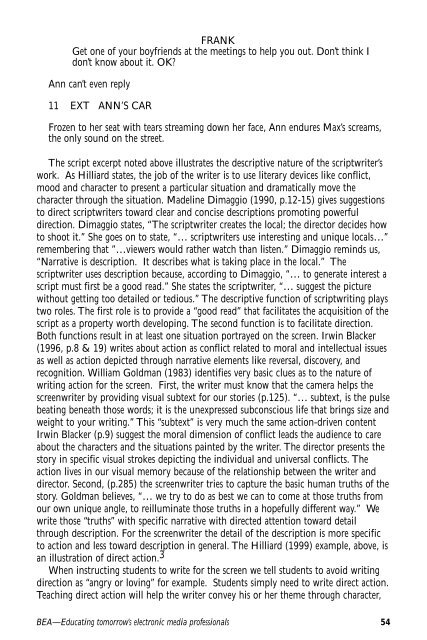PLANNING FOR GROWTH IN YEARS OF RESTRICTED RESOURCES
Feedback September 2003 - Broadcast Education Association
Feedback September 2003 - Broadcast Education Association
Create successful ePaper yourself
Turn your PDF publications into a flip-book with our unique Google optimized e-Paper software.
FRANKGet one of your boyfriends at the meetings to help you out. Don’t think Idon’t know about it. OK?Ann can’t even reply11 EXT ANN’S CARFrozen to her seat with tears streaming down her face, Ann endures Max’s screams,the only sound on the street.The script excerpt noted above illustrates the descriptive nature of the scriptwriter’swork. As Hilliard states, the job of the writer is to use literary devices like conflict,mood and character to present a particular situation and dramatically move thecharacter through the situation. Madeline Dimaggio (1990, p.12-15) gives suggestionsto direct scriptwriters toward clear and concise descriptions promoting powerfuldirection. Dimaggio states, “The scriptwriter creates the local; the director decides howto shoot it.” She goes on to state, “… scriptwriters use interesting and unique locals…”remembering that ”…viewers would rather watch than listen.” Dimaggio reminds us,“Narrative is description. It describes what is taking place in the local.” Thescriptwriter uses description because, according to Dimaggio, “… to generate interest ascript must first be a good read.” She states the scriptwriter, “… suggest the picturewithout getting too detailed or tedious.” The descriptive function of scriptwriting playstwo roles. The first role is to provide a “good read” that facilitates the acquisition of thescript as a property worth developing. The second function is to facilitate direction.Both functions result in at least one situation portrayed on the screen. Irwin Blacker(1996, p.8 & 19) writes about action as conflict related to moral and intellectual issuesas well as action depicted through narrative elements like reversal, discovery, andrecognition. William Goldman (1983) identifies very basic clues as to the nature ofwriting action for the screen. First, the writer must know that the camera helps thescreenwriter by providing visual subtext for our stories (p.125). “… subtext, is the pulsebeating beneath those words; it is the unexpressed subconscious life that brings size andweight to your writing.” This “subtext” is very much the same action-driven contentIrwin Blacker (p.9) suggest the moral dimension of conflict leads the audience to careabout the characters and the situations painted by the writer. The director presents thestory in specific visual strokes depicting the individual and universal conflicts. Theaction lives in our visual memory because of the relationship between the writer anddirector. Second, (p.285) the screenwriter tries to capture the basic human truths of thestory. Goldman believes, “… we try to do as best we can to come at those truths fromour own unique angle, to reilluminate those truths in a hopefully different way.” Wewrite those “truths” with specific narrative with directed attention toward detailthrough description. For the screenwriter the detail of the description is more specificto action and less toward description in general. The Hilliard (1999) example, above, isan illustration of direct action. 3When instructing students to write for the screen we tell students to avoid writingdirection as “angry or loving” for example. Students simply need to write direct action.Teaching direct action will help the writer convey his or her theme through character,BEA—Educating tomorrow’s electronic media professionals 54
















